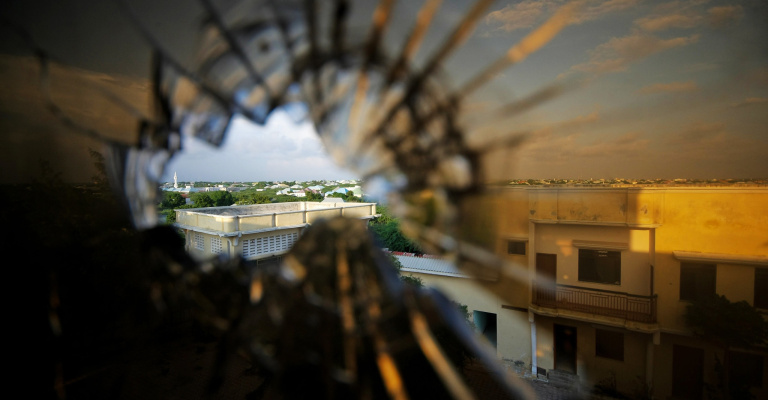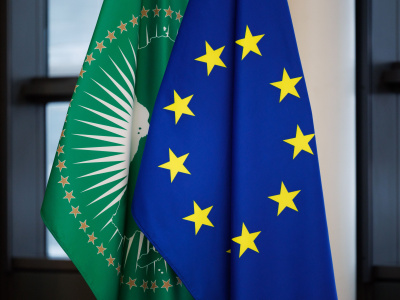
AU-EU summit: Does the EU still matter for Africa’s peace and security?
The 7th AU-EU summit, set for 24-25 November 2025, will take place in a vastly different geopolitical context compared to the previous summit in Brussels in 2022, held just days before the Russian invasion of Ukraine. Since then, the wars in Gaza and Sudan have escalated dramatically, with experts warning of ethnic cleansing and genocidal violence. Africa more broadly is experiencing a surge in armed conflict, with an increase in the number of conflicts of 45% since 2020 and more than 50 active conflict hotspots. While on the other side of the Mediterranean, Europe is spending more on defence and focuses on its own rearmament.
The summit offers a moment to step back and reflect: How has the relationship on peace and security between the African Union (AU) and the European Union (EU) developed? How should it evolve moving forward? And what should be the EU’s role?
Building on a long-term partnership
In the early 2000s, the EU played a very proactive role in assisting with the development of the AU’s institutional capacity, including the African Peace and Security Architecture (APSA), and its ability to play a decisive role in further shaping peace and security responses on the continent, including through African-led peace support operations.
A growing regionalisation of conflicts in Africa presents increasingly complex problems for both African and international actors.
But the APSA’s implementation has been increasingly bumpy over the years and the ability and relevance of the AU and the Regional Economic Communities (RECs) in handling crises became severely challenged. Fragmented and overlapping mandates among RECs, limited coordination, and resource dependencies have weakened its power. In some extreme cases, such as the Central Sahel, new intergovernmental formats are posing a direct challenge to RECs – in this case, ECOWAS. Overall, a growing regionalisation of conflicts in Africa presents today increasingly complex problems for both African and international actors.
The Joint AU-EU Vision for 2030, signed during the previous summit in February 2022, guides the EU’s current approach to respond to conflicts in Africa and provide support to the AU. Both parties agreed to strengthen and scale up African-led peace interventions; provide additional support for capacity building and equipment; to advance the discussion on the use of UN-assessed contributions for UN Security Council authorised peacekeeping operations; to promote the rule of law, including the implementation of the agendas in support of Women, Peace and Security (WPS), Children and Armed Conflict (CAAC) and Youth, Peace and Security (YPS); to comply with the human rights frameworks and, overall, to intensify cooperation on security, including cyber security.
The EU has attempted to provide sustainable, predictable and flexible financing towards this joint vision (primarily through the NDICI-Global Europe instrument and the European Peace Facility), complemented with political dialogue to strengthen and sustain the EU-Africa security partnership.
Since the previous Summit in 2022, there has been limited progress in strengthening cooperation between Africa and Europe on peace and security. One achievement was the joint effort to secure UN-assessed contributions for peacekeeping missions in Africa, culminating in the adoption of UN Security Council resolution 2719 in 2023. However, the resolution has yet to be operationalised – a testament to some of the remaining political hurdles both continents have to navigate in a new world marked by diplomatic transactionalism and competition, exacerbated by a highly UN-skeptic second Trump administration.
A growing focus on hard security
Over the past 15 years, the EU’s approach to international cooperation has become increasingly security oriented and, since the Russian invasion in Ukraine, more focused on defence and hard security. While peacebuilding and conflict prevention support have not been abandoned, several elements highlight an increase in the EU’s hard-security choices.
First, the African Peace Facility – ODA-funded and limited to providing non-lethal support – was replaced in 2021 by the European Peace Facility (EPF). Unlike its predecessor, the EPF operates under the authority of EU member states, has a global scope and can finance the provision of lethal equipment. The use of the EPF has become the principal tool for the EU to also become a geopolitical, security and military actor.
The contrast in priorities for the EU is stark when looking at the numbers of EPF spending. Since 2022, the EU and member states have mobilised €63.2 billion in military support for Ukraine. This includes €6.1 billion under the EPF for military support delivery and another €362 million under the EU Military Assistance Mission. Official and aggregated figures of EPF allocations to Africa are difficult to find, but an approximation made by the authors amounts to around €1.5 billion.
Second, the EU’s rationale has shifted from supporting ‘African solutions to African problems' towards framing EU foreign and security policies with a direct link between African stability and European security (and economic) interests.
Third, the focus on supporting the strengthening of the AU’s institutional structure and strengthening its operational engagement on peace and security has changed. The EU is increasingly establishing bilateral military partnerships with individual African states and ad-hoc coalitions, often bypassing the AU structures when perceived as slow or ineffective.
Finally, the EU’s regional support has become more pragmatic, attempting to develop more context-specific responses to the regionalisation of conflicts in Africa. This includes the launch of an EU security and defence initiative in support of West African countries of the Gulf of Guinea, with funding to armed forces under the EPF. In this region, the expansion of jihadist violence from the Central Sahel is seen as direct threats to the EU’s own security and economic interests. Such support is also considered necessary to counteract any potential vacuums, which could be quickly filled by other geopolitical global and regional actors and rivals, such as Russia, the Gulf States or China. These initiatives might also prove ever more urgent in light of the deteriorating situation in the Central Sahel – where direct (security) cooperation is still on hold.
Need for balancing hard-security funding with peacebuilding support…
In the search for a stronger defence posture, the EU risks losing grip on an area of crucial importance to respond to the deeper root causes of conflict and fragility. An analysis by the Global Public Policy Institute shows that peace, security and governance are not the focus they once were. Although not forgotten, the recent mid-term revision of the 2021-2027 Multiannual Financial Framework (MFF) revealed that “in almost every single case, the security, peace and governance-related programming priorities received less funding than any other priority”. Not only do such figures go against the actual conflict trends and the rising levels of fragility, but the cuts happen in envelopes that were already small and heavily depleted.
These cuts put serious question marks on how the EU is aiming to position itself on peace and security on the continent towards and with African partners.
In a context of dwindling support to development and peacebuilding, these cuts put serious question marks on how the EU is aiming to position itself on peace and security on the continent towards and with African partners. Fragility has emerged as an overarching factor to reckon with, including in the proposed Global Europe Instrument, but we warn that this risks politicising the EU’s engagement (in countries where there are clear EU economic, migration or security interests) rather than responding to needs on the ground.
One of the main reorientations in the proposal for the next MFF is the increase in defence to € 131 billion (compared to € 10 billion in the current budget). This includes renewed investments in research and innovation, and efforts to expand the defence industrial base. It also dovetails with the historical commitment of EU member states as members of NATO to increase their defence spending to 5%.
This allows to shift the budget between geographic regions and thematic priorities, making the EU’s funding – both to Africa, and to respond to fragility, resilience and peacebuilding – unpredictable.
The total amount for the proposed Global Europe Instrument is a little over € 200 billion – a supposed 75% increase from the current NDICI-GE. The increase is partly the result of the consolidation of three instruments into one, including humanitarian aid. The proposed new Global Europe Instrument under the next MFF includes an envelope for Sub-Saharan Africa of € 60.5 million. But there is an important caveat. The EU has introduced increased flexibility across the entire proposed EU budget, with no minimum spending targets for geographic envelopes or thematic earmarking, such as conflict prevention. This allows to shift the budget between geographic regions and thematic priorities, making the EU’s funding – both to Africa, and to respond to fragility, resilience and peacebuilding – unpredictable.
...and imagining a renewed EU-AU peace and security partnership
Taking the summit as a point of departure, the AU and EU will need to make serious choices, notably on how to balance military solutions with efforts to promote durable peace and security. Finding the right balance between hard security, security governance and conflict prevention needs to be on the agenda to strike the right tone with a primary partner for the foreseeable future.
This also relates to wider aspects of the partnership. Africa is diversifying its global orientation and partnerships, also in the domain of peace and security where the EU is not the dominant partner. To what extent is Europe prepared to respect and go along with African choices, support its strive for more sovereignty, contribute to strengthening regional integration, address factors underpinning fragility and work together long-term to promote a joint and mutually beneficial partnership?
The views are those of the authors and not necessarily those of ECDPM.





